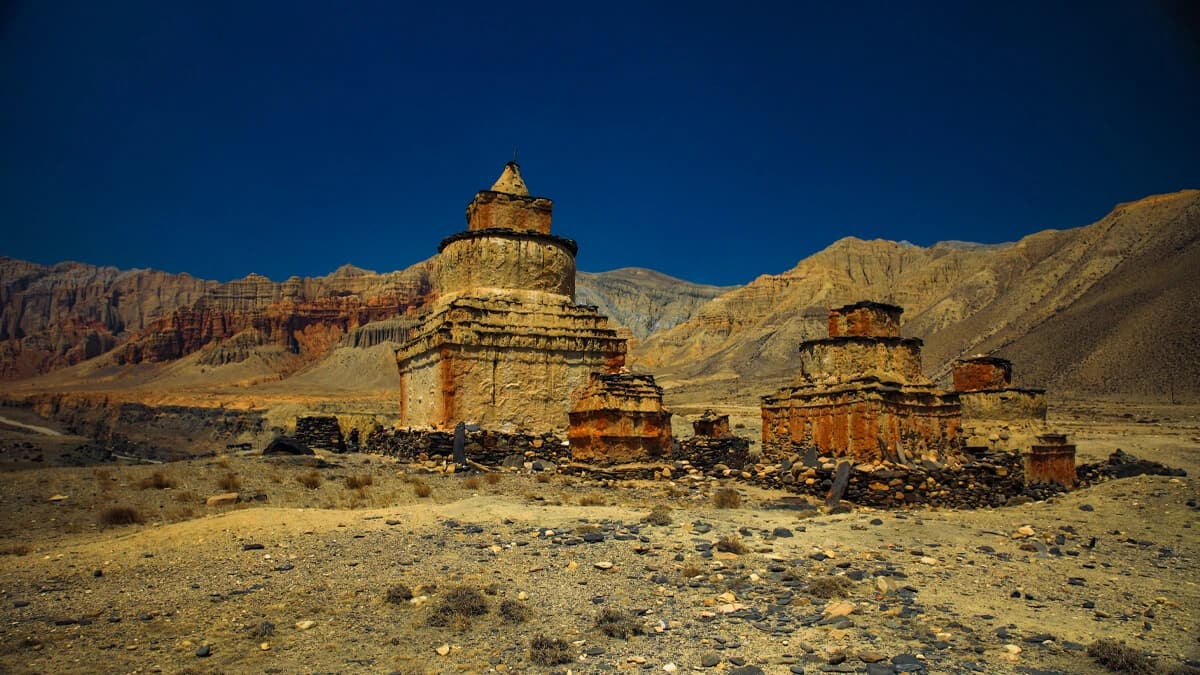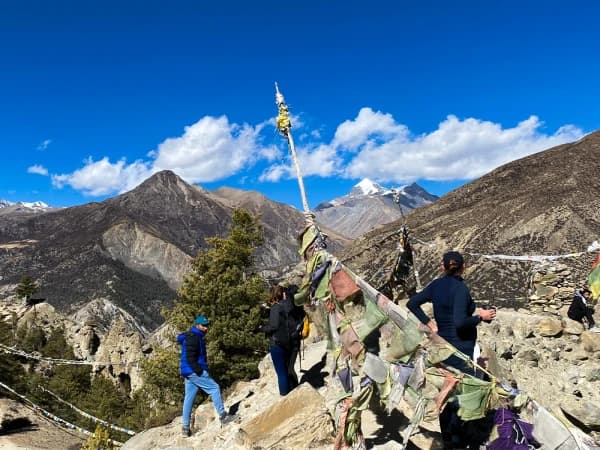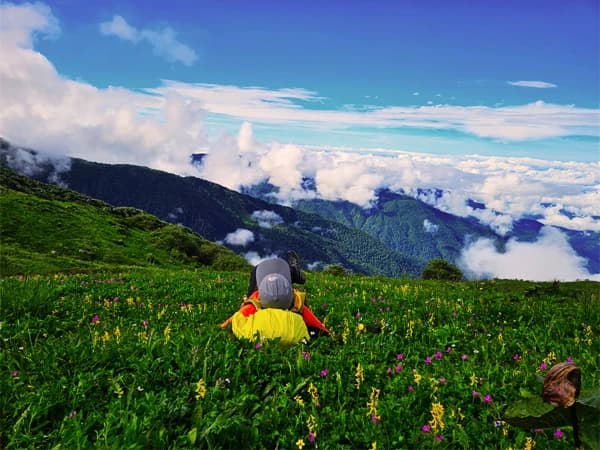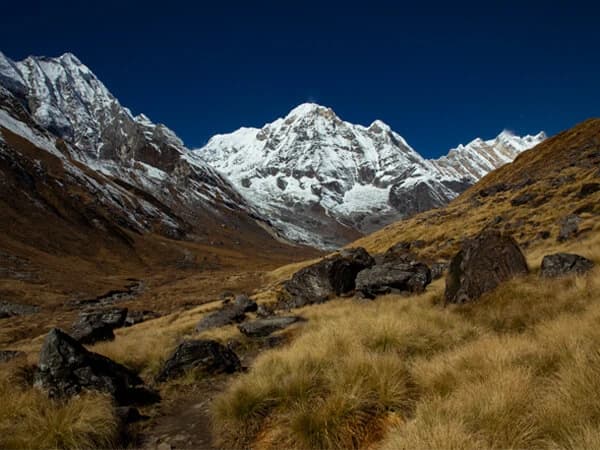Upper Mustang is a remote and culturally rich region in Nepal, known for its stark desert landscapes, ancient monasteries, and well-preserved Tibetan culture. Located north of the Annapurna range and bordering Tibet, Upper Mustang was once part of the independent Kingdom of Lo and remained isolated from the outside world until the 1990s.
The region is often referred to as the "Last Forbidden Kingdom" due to its long-standing restriction on tourism, which helped preserve its unique heritage and traditions. The trek through Upper Mustang takes you into the heart of this former kingdom, with the walled city of Lo Manthang as the cultural and spiritual centerpiece. Lo Manthang is renowned for its centuries-old monasteries, royal palaces, and the vibrant Tiji Festival, which draws visitors from around the world.
The landscapes of Upper Mustang are unlike any other in Nepal, featuring dramatic red cliffs, eroded rock formations, and high-altitude deserts, all set against the backdrop of the snow-capped Himalayas. The region’s isolation and arid environment have resulted in a distinct way of life, with traditional Tibetan Buddhism deeply woven into the daily lives of its inhabitants.
The Upper Mustang Trek offers a unique journey into a remote, culturally rich region in Nepal, close to the Tibetan border. This trek is distinct for its arid, windswept landscapes, dramatic cliffs, and colorful rock formations, which contrast with the lush greenery found in other parts of Nepal. Trekking through Upper Mustang feels like stepping into a different world, where the Tibetan influence is strong, evident in the architecture, language, and customs of the people. The highlight of the trek is the ancient walled city of Lo Manthang, a 15th-century capital filled with monasteries, palaces, and Tibetan art. Access to Upper Mustang is restricted, requiring a special permit, which helps preserve its unique culture and environment.
Upper Mustang offers a rare opportunity to explore a well-preserved corner of Tibetan culture within Nepal, making it a unique and unforgettable trekking destination.
Highlights
Kagbeni: A picturesque village at the gateway to Upper Mustang, known for its ancient monasteries, traditional mud-brick houses, and panoramic views of the Nilgiri and Dhaulagiri mountains.
Muktinath Temple: A significant pilgrimage site for both Hindus and Buddhists, featuring the famous eternal flame and 108 water spouts.
Marpha Village: Renowned for its apple orchards and traditional whitewashed houses, Marpha offers a charming blend of natural beauty and cultural heritage.
Kali Gandaki Gorge: Experience trekking through one of the world's deepest gorges, with spectacular views of the surrounding peaks and dramatic landscapes.
Lo Manthang: The ancient walled city and capital of the former Kingdom of Lo, rich in Tibetan culture, with historic monasteries, palaces, and stunning Himalayan views.
Desert-Like Landscapes: Be in awe of Upper Mustang's distinctive, arid terrain, which features red cliffs, eroded hills, and barren plateaus that resemble a desert.
Monasteries and Caves: Discover ancient Buddhist monasteries, such as the Thubchen and Jampa Gompas, and explore the mysterious cave dwellings carved into cliffs.
Cultural immersion: Engage with the local Tibetan communities, experiencing their preserved traditions, festivals, and warm hospitality in remote villages.
Luri Gompa: Visit this remote monastery famous for its intricate murals and the mysterious cave complex it is nestled within.
What should I expect during the Upper Mustang Circuit Trek?
When booking the Upper Mustang trek with a Sherpa Eco Adventure, clients should expect a comprehensive package that ensures a safe, comfortable, and culturally immersive experience. Typically, this includes:
Permit Arrangement: The Sherpa Eco Adventure will handle obtaining the necessary permits, such as the Restricted Area Permit for Upper Mustang and the Annapurna Conservation Area Permit (ACAP). Assistance with visa extensions if needed will also be provided.
Transportation: The package usually includes round-trip flights between Kathmandu and Pokhara and from Pokhara to Jomsom, where the trek begins. Ground transportation from the airport to the hotel and the trekking start point will also be arranged.
Accommodation: Clients can expect comfortable hotel stays in Kathmandu and Pokhara with breakfast. During the trek, accommodations are typically in clean, basic tea houses or lodges, often with twin-sharing rooms and shared bathrooms. In Lo Manthang, special arrangements may be made for stays in guesthouses that offer a closer experience of local life.
Meals: The package includes full board during the trek, with three meals a day (breakfast, lunch, and dinner), often featuring local and Tibetan cuisine. The ability to accommodate special dietary needs (vegetarian, vegan, gluten-free, etc.) is also important.
Guides and Porters: Clients can expect knowledgeable, English-speaking trekking guides familiar with the region, culture, and routes. Guides should be trained in first aid and altitude sickness. Porter services should also be provided, allowing clients to trek with just a daypack, with porters typically carrying 15-20 kg, shared between two clients.
Cultural Insights: The trek should include cultural orientation sessions or briefings on Upper Mustang’s culture, history, and traditions, along with visits to monasteries, caves, and local villages. If the trek coincides with a local festival, the travel company should facilitate participation or observation.
Health and Safety: The Sherpa Eco Adventure should have precautions in place for altitude sickness, including gradual acclimatization plans and information on recognizing and responding to symptoms. Guides will carry a comprehensive first-aid kit, and the Sherpa Eco Adventure will have a plan for managing emergencies, including evacuation if necessary. Clients are advised to have travel insurance that covers high-altitude trekking and emergency evacuation.
Trekking Equipment: Assistance with renting or purchasing necessary trekking gear, such as sleeping bags, down jackets, and trekking poles, should be provided if clients don’t bring their own. Detailed packing lists and recommendations on what to bring will also be available.
Communication: Daily briefings during the trek and the ability to contact the Sherpa Eco Adventure’s office or emergency contact will be provided. We may also offer access to satellite phones or information on mobile network availability where the mobile network does not work.
Environmental Responsibility: The Sherpa Eco Adventure will emphasize responsible trekking practices, such as waste management and respecting local customs and nature. Supporting local communities by engaging in fair trade practices and contributing to the community in Upper Mustang is also important.
Flexibility and Support: Clients should expect flexibility in customizing the itinerary based on their preferences, fitness levels, and interests. Post-trek services, such as assistance with additional travel arrangements or sightseeing in Nepal, will also be offered.
Perks of doing the Upper Mustang Circui trek with us.
Doing the Upper Mustang Circuit Trek with a Sherpa Eco Adventure offers numerous perks that significantly enhance the experience. A Sherpa Eco Adventure handles all logistical aspects, including the acquisition of necessary permits, transportation arrangements, and accommodation bookings, ensuring a hassle-free journey. Experienced guides provide valuable insights into the region’s culture, history, and terrain while also offering safety, support, particularly in managing altitude-related challenges.
This guidance allows for a deeper cultural immersion, with opportunities for authentic interactions with local communities and participation in traditional practices. Sherpa Eco Adventure also ensures comfort and convenience by organizing meals, accommodating dietary needs, and providing porter services, allowing trekkers to enjoy the journey with minimal physical strain. Additionally, they offer tailored itineraries that consider individual fitness levels and interests, ensuring a personalized trekking experience.
The social aspect of group travel is another benefit, fostering connections with like-minded adventurers. Furthermore, reputable companies prioritize sustainable travel practices, contributing positively to the local economy and environment. Overall, trekking with a Sherpa Eco Adventure provides peace of mind, allowing you to focus on the adventure while they handle all the details.



